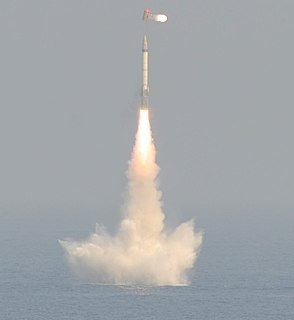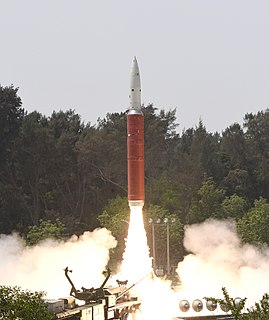Related Research Articles

An anti-ballistic missile (ABM) is a surface-to-air missile designed to counter ballistic missiles. Ballistic missiles are used to deliver nuclear, chemical, biological, or conventional warheads in a ballistic flight trajectory. The term "anti-ballistic missile" is a generic term conveying a system designed to intercept and destroy any type of ballistic threat; however, it is commonly used for systems specifically designed to counter intercontinental ballistic missiles (ICBMs).

India has developed and possesses weapons of mass destruction in the form of nuclear weapons. Although India has not released any official statements about the size of its nuclear arsenal, recent estimates suggest that India has 160 nuclear weapons and has produced enough weapons-grade plutonium for up to 161–200 nuclear weapons. In 1999, India was estimated to have 800 kg of separated reactor-grade plutonium, with a total amount of 8,300 kg of civilian plutonium, enough for approximately 1,000 nuclear weapons. India has conducted nuclear weapons tests in a pair of series namely Pokhran I and Pokhran II.

The Defence Research and Development Organisation (DRDO) is an agency under the Department of Defence Research and Development in Ministry of Defence of the Government of India, charged with the military's research and development, headquartered in Delhi, India. It was formed in 1958 by the merger of the Technical Development Establishment and the Directorate of Technical Development and Production of the Indian Ordnance Factories with the Defence Science Organisation.
The Strategic Forces Command (SFC), sometimes called Strategic Nuclear Command, forms part of India's Nuclear Command Authority (NCA). It is responsible for the management and administration of the country's tactical and strategic nuclear weapons stockpile. It was created on 4 January 2003 by the Vajpayee Government. Air Marshal Teja Mohan Asthana became its first commander-in-chief.
The Indian Ballistic Missile Defence Program is an initiative to develop and deploy a multi-layered ballistic missile defence system to protect India from ballistic missile attacks. Phase 1 has been successfully tested and completed and deployment awaits final official permission. Phase 2 is under development.

The Shaurya missile is a canister launched hypersonic surface-to-surface tactical missile developed by the Indian Defence Research and Development Organisation (DRDO) for use by the Indian Armed Forces. It has a range of 700 to 1,900 km and is capable of carrying a payload of 200 kg to 1 tonne conventional or nuclear warhead. It gives the potential to strike at very-long-range against any adversary.
Swordfish is an Indian active electronically scanned array (AESA) long-range tracking radar specifically developed to counter ballistic missile threat. It will be a part of the Indian Ballistic Missile Defence Programme. First testing of this radar was in March 2009. Main aim of the test was to validate the capabilities of the Swordfish Long Range Tracking Radar (LRTR). "The missile to be hit will be fired from a longer distance than it was in the earlier test. DRDO tested whether the radar could track the incoming missile from that distance or not," said a member of the project. This radar is an acknowledged derivative of the Israeli EL/M-2080 Green Pine long range radar, which is the critical component of that country's Arrow missile defence system. However, it differs from the Israeli system as it employs Indian Transmit Receive modules, signal processing, computers and power supplies. It is also more powerful than the base Green Pine system and was developed to meet India's specific BMD needs.
A Sivathanu Pillai is an Indian scientist who formerly served as Honorary Distinguished Professor at Indian Space Research Organisation (2015-2018) and an honorary professor at IIT Delhi in the Department of Mechanical Engineering (2015-2016) and a Visiting Professor at Indian Institute of Science (2014-2015).
The Indian Air Force has been undergoing a modernization program to replace and upgrade its aging and outdated equipment since the late 90s to modern standards. For that reason it has started procuring and developing aircraft, weapons, associated technologies, and infrastructures. Some of these programs date back to the late 80s. The primary focus of current modernization and upgrades is to replace aircraft purchased from the Soviet Union that currently form the backbone of the Air Force.
Agni-VI is an intercontinental ballistic missile developed by the Defence Research and Development Organisation (DRDO) for the Strategic Forces Command (SFC) of Indian Armed Forces.

The K family of missiles, named after Indian scientist and former president A. P. J. Abdul Kalam, is a family of submarine-launched ballistic missiles (SLBM) developed by India to boost its second strike capabilities and thus augment its nuclear deterrence. Information about this family of missiles has mostly been kept classified. It is reported that "K" missiles are faster, lighter and stealthier than their Agni missile counterparts.

Tessy Thomas is an Indian scientist and Director General of Aeronautical Systems and the former Project Director for Agni-IV missile in Defence Research and Development Organisation. She is the first ever woman scientist to head a missile project in India.
The use of rockets in India, for warfare, dates back to the 18th century. Mysorean rockets were the first iron-cased rockets that were successfully deployed for military use, reverse-engineered by British and introduced in the Europe as Congreve rocket. After British colonisation of India, scientific R&D in Indian dynasties was restricted and military science in India lagged.
Missile defense systems are a type of missile defense intended to shield a country against incoming missiles, such as intercontinental ballistic missile (ICBMs) or other ballistic missiles. The United States, Russia, India, France, Israel, Italy, United Kingdom and China have all developed missile defense systems.
Prahlada is an Indian missile scientist, former vice chancellor of Defence Institute of Advanced Technology and a former director of Defence Research and Development Laboratory, the largest of the Defence Research and Development Organization laboratories in India, known for his contributions to Indian space programme. He was honoured by the Government of India in 2015 with Padma Shri, the fourth highest Indian civilian award.
N. Prabhakar is an Indian scientist and the Chief Controller, System Analysis and Modelling Centre (SAM-C) of the Defence Research and Development Organization (DRDO). He graduated in Electrical and Electronics Engineering (BE) from Annamalai University and enrolled at the Indian Institute of Science, Bengaluru from where he obtained his master's degree (ME). He pursued his research at Shanmugha Arts, Science, Technology & Research Academy, secured a doctoral degree in Air Defence Systems and joined the Defence Research and Development Laboratory (DRDL) in 1980.
INS Dhruv is a research vessel and missile range instrumentation ship built by India's Hindustan Shipyard Limited (HSL). The ship was earlier only known by it's shipyard designated yard number as VC-11184.

Quick Reaction Surface-to-Air Missile (QRSAM) is a missile developed by the Defence Research and Development Organisation (DRDO), Bharat Electronics Limited and Bharat Dynamics Limited for the Indian Army, meant for protecting moving armoured columns from aerial attacks.

On 27 March 2019, India tested an anti-satellite weapon during an operation code named Mission Shakti. The target of the test was a satellite present in a low Earth orbit, which was hit with a kinetic kill vehicle.
The Defence Space Agency(DSA) is a tri-service agency of the Indian Armed Forces. Headquartered in Bengaluru, Karnataka, India. The agency is tasked with operating the space-warfare and Satellite Intelligence assets of India. The DSA draws personnel from all three branches of the Armed Forces.
References
- 1 2 3 Geetanath, V. (9 March 2017). "At the vanguard of the interceptor missile success". The Hindu. ISSN 0971-751X . Retrieved 1 June 2020.
- 1 2 3 Isaac, Christopher (9 March 2017). "Meet Shashikala, The missile woman". Deccan Chronicle. Retrieved 1 June 2020.
- ↑ "Dr Shashikala Sinha – ET Women's Forum" . Retrieved 1 June 2020.
- ↑ Somasekhar, M. (13 January 2018). "Shashikala Sinha, the scientist behind the ballistic missile shield". The Hindu @businessline. Retrieved 15 August 2020.